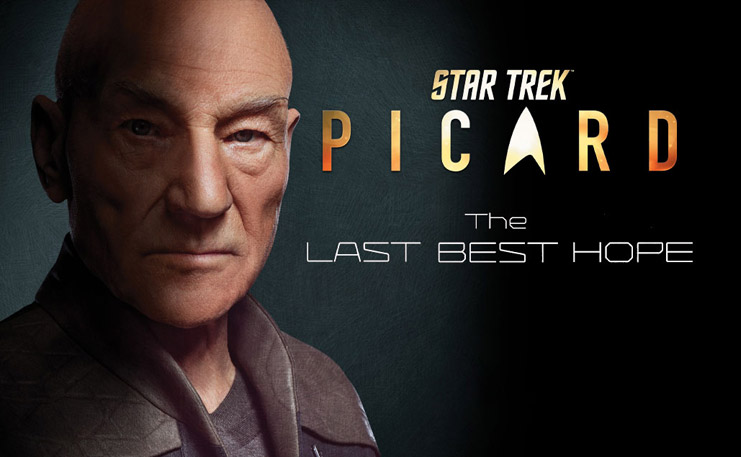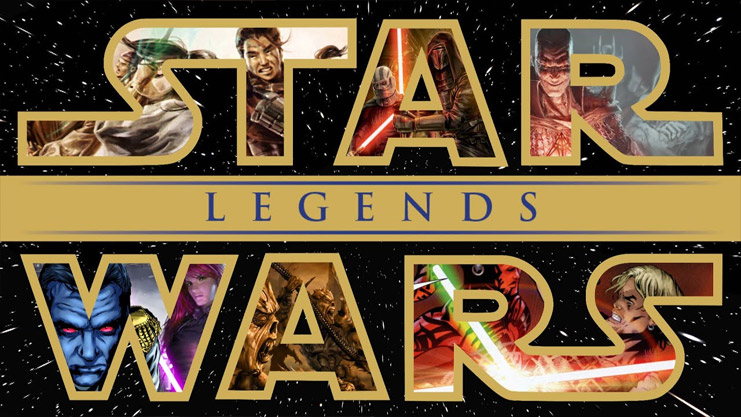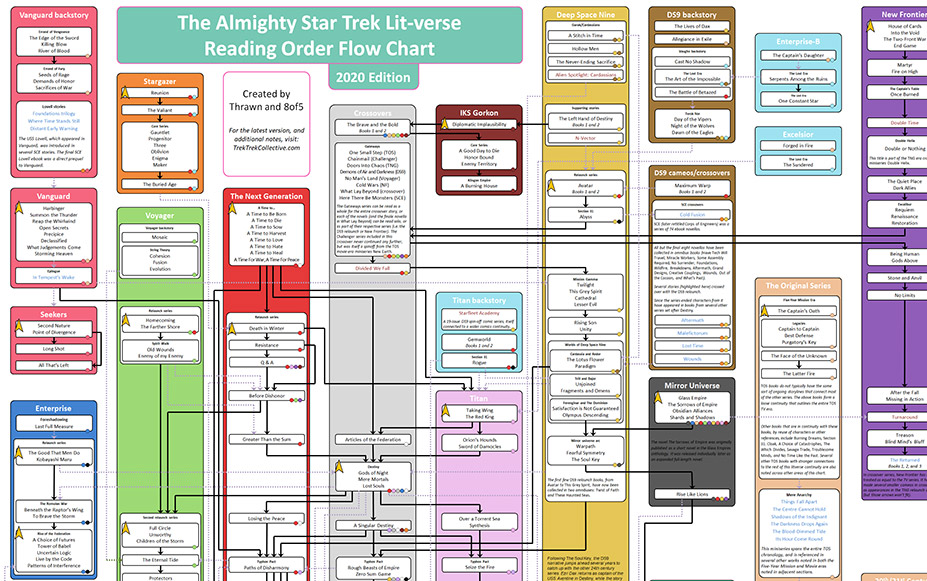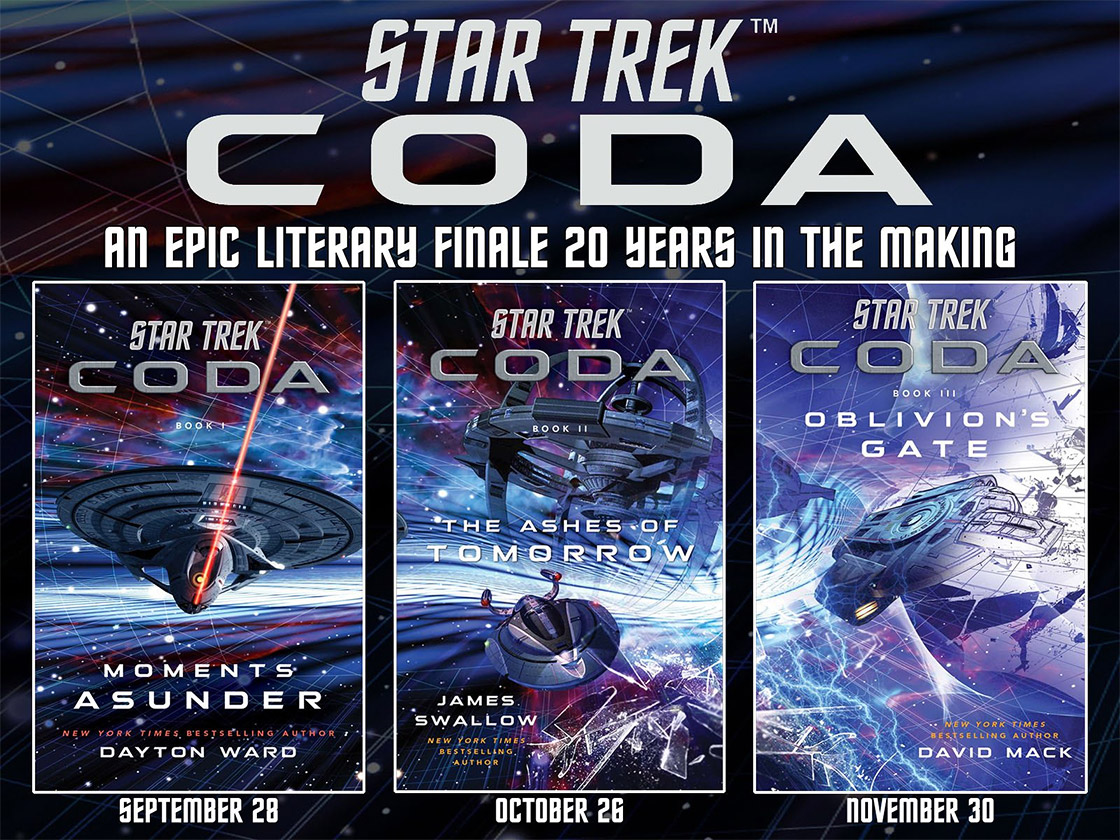The biggest Star Trek literary event of the decade starts this week, as the Star Trek: Coda trilogy marks the closing chapter of over 20 years of Trek novel continuity.
The ongoing novel-verse continuity kicked off with Avatar, the opening entry 2001’s Star Trek: Deep Space Nine “relaunch” book series and for the last two decades has maintained an ever-growing, interconnected text-only universe that’s followed our Trek heroes since the end of the Berman-era television shows.
Since the launch of Star Trek: Discovery in 2017, the storylines of the non-canon books have been on shaky ground, but with Star Trek: Picard arriving in 2020, it’s become clear that the 24th century as represented in the novels is no longer compatible with on-screen Star Trek canon.
But that’s a challenge that the writing team of Dayton Ward, James Swallow, and David Mack have taken head on, crafting the three-part Coda saga as a natural conclusion for the Star Trek novel continuity — in a way that doesn’t just throw the long-running stories out the window, after so many fans have enjoyed the tales over the years.
To get an idea of just what went into this massive undertaking, we talked with Trek author Dayton Ward — writer of the first Coda novel, Moments Asunder — about his experience working within the Star Trek story continuity universe, the genesis of the Coda trilogy, and more.
TREKCORE: Though you wrote several books before it, your 2011 novel Paths of Disharmony was your first venture in to the post-series novel continuity. What was it like stepping into this world, years before we thought Trek would return to television?
DAYTON WARD: The Typhon Pact series was my first actual contribution to that post-movie continuity — after dipping my toes in the water with A Time To Sow, and the Starfleet Corps of Engineers series — and Paths of Disharmony, was part of the larger Typhon Pact mini-series.
It was interesting to try to dive into all that. It required a lot of homework, because I hadn’t really been paying that close attention to what was going on. And then they called me back to write the conclusion for The Fall mini-series, Peaceable Kingdoms, which was another political thing, another “Picard is in the throes of a midlife crisis” thing.
I basically asked my editor, Margaret Clark, “Okay at the end of this, when we do these five books, and we have this political thing… can I please set things up so the Enterprise goes back to being explorers again?”
And Margaret was all about it. I set it up so that whoever was going to write the next TNG book would have an open road and a clean slate. I left it as open as I possibly could for whoever was going to be next, not knowing for a second that it was going to be me. But then Margaret called me up and asked me to do another TNG book that takes place after The Fall.
At that point, I was like, “Well, I’m glad I set things up that way — now I get to go have fun.” Those things happen sometimes.

TREKCORE: You wrote four additional novels in the Next Gen “relaunch” series after The Fall concluded. How much thought had you put into where those stories were heading — before Picard was announced — like that thread where Taurik got a glimpse of the future in Armageddon’s Arrow?
WARD: I had a few ideas about what I could do with Taurik’s information and his future knowledge; nothing really nailed down. I just had some broad-stroke ideas that I could pivot to based on anything, whether I’m left to my own devices or another big cross-series project comes along where it would be good to use it.
Of course, at the time one of the considerations that was still out there, even though we weren’t sure if we’d ever be able to do it, was that the book timeline was inching closer to the Romulan supernova [as established in the first Kelvin Timeline Star Trek film].
That was always in the back of our minds — but at that time we were told we could not reference anything from the Bad Robot films. All that was off-limits, because of the separation between CBS and Paramount Pictures. For us, the Romulan supernova was a pin on the whiteboard of where things might eventually head, like, “Oh, you never know….”
The supernova was probably the leading contender for the story about Taurik’s future knowledge, but it was still a very remote possibility. But then we moved into the book version of the Control story, which was led by David Mack — and the fallout from that — so it was a while before we needed to come back to it.

TREKCORE: Did you ever actually have thoughts on how you would have tackled the Romulan supernova in print, if you had been given the chance?
WARD: I don’t remember any conversations about it, other than maybe just ballparking and throwing things around [with other Trek authors] to see what might stick. I don’t know that we ever actually cracked any serious story idea about it.
Of course, now Picard has retconned some of the details about the supernova. But what’s interesting is that there’s really still a lot of stuff out there about how and why, and what was behind the supernova from Picard. Who knows when they’ll decide they want to address that.
TREKCORE: What was your reaction to Patrick Stewart’s return in Picard, in terms of how it would impact the Star Trek novels?
WARD: In the early part of 2018, I knew that Picard was going to happen. Fellow author and Star Trek: Picard co-creator Kirsten Beyer called me, and said, “Hey, we’ve got Patrick Stewart to come back and play Picard!” I thought, “Wow, that’s going to be a problem for the books!”
I didn’t hear anything more about it for months and months and months. By the time they announced the show in at Star Trek Las Vegas in August 2018, I had a vague idea of the direction of the show. I had been given a document by Kirsten Byer where she had given the show’s new writers a primer document of all the relevant big-ticket events in time from across the Star Trek timeline.
That document also laid in key points of backstory specific to Picard that would inform its storyline, like the synth attack on Mars, and other things that they did not reveal until much later. That’s when I knew we were definitely dealing with an issue that was going to impact the novels.
Starting in the late summer 2018 is when I really started jotting down notes — and unbeknownst to me, my fellow author Dave Mack is doing the same thing. And once I started reading scripts for Picard, and I realized where things were going, I sat down with Dave in the summer of 2019 at the annual Shore Leave Convention to talk through it all
He had told me that he and another longtime Star Trek author, Jim Swallow, had started asking, “What do we do about the books?” Dave outlined an idea that he and Jim had put together — the only difference between what Jim and Dave were doing, and what I was doing, was that I had read the Picard scrips for Season 1, and they hadn’t seen them.
“Dude,” I told him, “We have got so much more work to do than you think, to make this work.”

TREKCORE: So they were already trying to find paths to help guide the novel stories to wherever Picard was headed…
WARD: Yes — Dave was like, “We can bring back the Borg, and we can do all sorts of things to reconcile the two stories together!”
But the point of divergence for the novels and Picard start to go off the rails 15 years in the show’s backstory, at that point, the current time period in the books were like two or three years past that… which meant that everything that came after in the books was totally incompatible. We were already toast.
So we decided to turn our attention to coming up with something really cool, and epic, and insane, to give book fans closure. We pitched a few ideas, and we talked to Margaret Clark at Simon & Schuster, and we got her support. We got in-house editor Ed Schlesinger’s support, and then we got John Van Citters at CBS Consumer Products to bless the idea — and then we went to work.
TREKCORE: Did the Star Wars franchise’s handling of their legacy novels — dumping most of their Expanded Universe in 2014 after the Disney acquisition — influence how your team handled the Coda project?
WARD: Oh, absolutely it did. We did not want to do that. We did not want to go down that road. When we first started to get a sense of just what was involved in realigning the book lines with the new shows, we said we don’t want to do a Star Wars.
We definitely don’t want to tell people who’ve been buying these books for 20 years, “None of this counts, none of this matters, you wasted all your time and your money. Oh, and by the way, buy our new books which are tied back into the show now!”
How do you sell that? You don’t. The Star Trek book audience might not be as big as the Star Wars book audience, but I would argue that they are as loyal — if not more so — for sticking with us as long as they have.
We definitely did not want to do something like that. It was never even a serious conversation. Even our editors at Simon & Schuster and John Van Citters at CBS understood the need to do this, and told us to go forth and write.

TREKCORE: While some of the arcs have reached natural conclusions, there were still a number of novel story threads still awaiting resolution, like Sisko’s daughter being part Prophet. How did you decide what to “wrap up” while developing Coda?
WARD: That was a tall order. We definitely sat down, and we figured out, “Okay, what do we have to work with? What’s still on the table?”
We had originally pitched four books, and I had actually proposed at least one book that I called a “stealth setup book,” which would seem to the reader like a standard adventure — either a TNG or DS9 book — and only after you started reading Coda would you realize we already had things moving into place ahead of time. But that part didn’t work out and we only got three books to tell the story.
We decided that we wanted to give as many characters a moment in the sun, so to speak, as we could — but we needed to find what unresolved storylines could have the maximum impact on Coda; where the stakes would be high, real, and the payoff would be worth it.
We looked for moments where we could make a reference to things, or include a quick scene for this person, or involve a crew that you haven’t seen for a while, that kind of thing. It took a lot of planning and coordination — all the emails, the Skype calls, the spreadsheets shared between Dave, Jim and myself were pretty maddening.
As a fan, I wanted to see this done right. There’s a very small roster of people that I would trust to do it, but we were limited by folks’ availability. We tried to get Una McCormack involved in Coda, for example, but she had other demands on her time.

TREKCORE: While some people, like me, have been reading for 20 years, will these books going to be accessible to fans who might be using Coda as their first entry into Star Trek books at the end of this long-running thing?
WARD: Well, we knew that going in that these books that we were going to attract attention beyond the loyal folks who follow us book after book, so we wanted to make them accessible. Everything that we believe is critical to the storyline, and the larger continuity, is explained in the book in some manner.
Obviously, if you’ve been following along since day one, or you hopped on the train, and you caught up, and now you’re ready for Coda, you’ll get more out of it may be in some level than a person who’s dove right in. But we hope that when those readers get to the end of these books, it’ll make them want to go back and read all the stuff they missed.
This is the culmination of many years of storytelling in which many, many writers participated. We wanted to honor all of that — and at the same time, you can still look at them on the shelf and go, “Yes. Those stories matter, I can still count them in my ‘head canon,'” that kind of thing.
That’s coming as both a fan and a writer. I’ve been reading Star Trek books since I was 12. I grew up reading the old Bantam books in the stuff in the 70s. I hopped on Simon & Schuster’s train with the very first book they ever put out, and have been with them the whole 40-plus years.
TREKCORE: Not to spoil anything here, but what do you hope readers feel when they get to the end of Moments Asunder?
WARD: Pardon my French, but I hope they feel like, “Holy shit, what comes next?” That’s what I want — but I suspect I will catch some heat for some of my choices in there.
When I say “my choice,” I want to be clear that that these books are very much a collaborative effort, so even though my name is on this book, and Jim and Dave’s names are on the others, we hammered out the storyline together — down to the smallest detail.
If you look inside the title page, you’ll see that the story credit is by all three of us, and that’s across the three books. I did not unilaterally make some of the choices that are going to anger people in that book. So fans can be mad at all three of us!
ZOMG LOOKIE WHAT THE BOOK FAIRY BROUGHT.
Minty fresh copies of MOMENTS ASUNDER in da house! Let's get this temporal apocalypse started! #StarTrek #StarTrekCoda pic.twitter.com/D4r1kV5bC0
— Dayton Ward 🖖😎 (@daytonward) August 27, 2021
TREKCORE: And when they’ve finished the trilogy, how to you hope fans will react?
WARD: I hope that they will come away knowing that we worked very hard to pay tribute to everything they’ve read for the past 20 years — and I hope that all the other writers who have participated in building this continuity feel like that their work and time was not wasted.
I also hope that readers don’t feel like we wasted their money. That was at the forefront of everything we were doing, it was always in our brain. It’s like, “How are the fans going to react to this?”
At the end of it all, I hope that readers come away with the idea this was a real labor of love that respects them and respects what’s come before.
TREKCORE: With the conclusion of Coda, is that it for Dayton Ward and Star Trek novels?
WARD: I cannot imagine I’m done with Star Trek, at least in some form. I’m still doing consulting work for ViacomCBS, and my fingers are in a number of different Star Trek pies right now.
But in terms of the novels, I don’t know. I never say never; we’ll have to wait and see. We have all these new shows, and other in development that they’re talking about, so there are a lot of different playgrounds to entertain ourselves with.
TREKCORE: Of the five shows happening now — Discovery, Picard, Lower Decks, Prodigy, and Strange New Worlds — is there one you’d really like to write for, given the opportunity?
Dayton Ward: If they gave me the choice, I think I would like to take a shot at Strange New Worlds because that’s close to The Original Series, and that’s my favorite.
At the same time though, I am very excited about Prodigy. I am very excited by what it’s attempting to do, and what it hopes to do — the potential there is just phenomenal.
If they came to me and asked me to write something tying into Prodigy, I would probably jump at it.
Read more from Dayton Ward at DaytonWard.com or on Twitter.
This interview has been condensed and edited for clarity.
![]()
Star Trek: Coda #1 — Moments Asunder arrives on September 28, followed by James Swallow’s Star Trek: Coda #2 — The Ashes of Tomorrow in October, and David Mack’s Star Trek: Coda #3 — Oblivion’s Gate in November.
Watch for our review of Dayton Ward’s Moments Asunder later this week!


